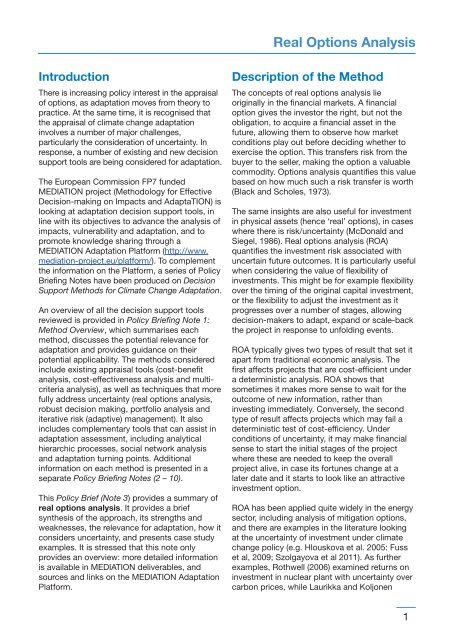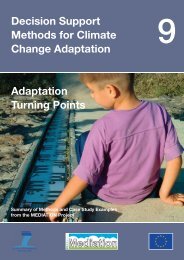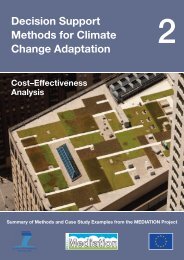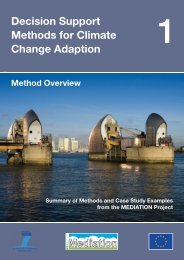Download all Technical Policy Briefing Notes in a single ... - Mediation
Download all Technical Policy Briefing Notes in a single ... - Mediation
Download all Technical Policy Briefing Notes in a single ... - Mediation
- No tags were found...
You also want an ePaper? Increase the reach of your titles
YUMPU automatically turns print PDFs into web optimized ePapers that Google loves.
Real Options AnalysisIntroductionThere is <strong>in</strong>creas<strong>in</strong>g policy <strong>in</strong>terest <strong>in</strong> the appraisalof options, as adaptation moves from theory topractice. At the same time, it is recognised thatthe appraisal of climate change adaptation<strong>in</strong>volves a number of major ch<strong>all</strong>enges,particularly the consideration of uncerta<strong>in</strong>ty. Inresponse, a number of exist<strong>in</strong>g and new decisionsupport tools are be<strong>in</strong>g considered for adaptation.The European Commission FP7 fundedMEDIATION project (Methodology for EffectiveDecision-mak<strong>in</strong>g on Impacts and AdaptaTION) islook<strong>in</strong>g at adaptation decision support tools, <strong>in</strong>l<strong>in</strong>e with its objectives to advance the analysis ofimpacts, vulnerability and adaptation, and topromote knowledge shar<strong>in</strong>g through aMEDIATION Adaptation Platform (http://www.mediation-project.eu/platform/). To complementthe <strong>in</strong>formation on the Platform, a series of <strong>Policy</strong><strong>Brief<strong>in</strong>g</strong> <strong>Notes</strong> have been produced on DecisionSupport Methods for Climate Change Adaptation.An overview of <strong>all</strong> the decision support toolsreviewed is provided <strong>in</strong> <strong>Policy</strong> <strong>Brief<strong>in</strong>g</strong> Note 1:Method Overview, which summarises eachmethod, discusses the potential relevance foradaptation and provides guidance on theirpotential applicability. The methods considered<strong>in</strong>clude exist<strong>in</strong>g appraisal tools (cost-benefitanalysis, cost-effectiveness analysis and multicriteriaanalysis), as well as techniques that morefully address uncerta<strong>in</strong>ty (real options analysis,robust decision mak<strong>in</strong>g, portfolio analysis anditerative risk (adaptive) management). It also<strong>in</strong>cludes complementary tools that can assist <strong>in</strong>adaptation assessment, <strong>in</strong>clud<strong>in</strong>g analyticalhierarchic processes, social network analysisand adaptation turn<strong>in</strong>g po<strong>in</strong>ts. Additional<strong>in</strong>formation on each method is presented <strong>in</strong> aseparate <strong>Policy</strong> <strong>Brief<strong>in</strong>g</strong> <strong>Notes</strong> (2 – 10).This <strong>Policy</strong> Brief (Note 3) provides a summary ofreal options analysis. It provides a briefsynthesis of the approach, its strengths andweaknesses, the relevance for adaptation, how itconsiders uncerta<strong>in</strong>ty, and presents case studyexamples. It is stressed that this note onlyprovides an overview: more detailed <strong>in</strong>formationis available <strong>in</strong> MEDIATION deliverables, andsources and l<strong>in</strong>ks on the MEDIATION AdaptationPlatform.Description of the MethodThe concepts of real options analysis lieorig<strong>in</strong><strong>all</strong>y <strong>in</strong> the f<strong>in</strong>ancial markets. A f<strong>in</strong>ancialoption gives the <strong>in</strong>vestor the right, but not theobligation, to acquire a f<strong>in</strong>ancial asset <strong>in</strong> thefuture, <strong>all</strong>ow<strong>in</strong>g them to observe how marketconditions play out before decid<strong>in</strong>g whether toexercise the option. This transfers risk from thebuyer to the seller, mak<strong>in</strong>g the option a valuablecommodity. Options analysis quantifies this valuebased on how much such a risk transfer is worth(Black and Scholes, 1973).The same <strong>in</strong>sights are also useful for <strong>in</strong>vestment<strong>in</strong> physical assets (hence ‘real’ options), <strong>in</strong> caseswhere there is risk/uncerta<strong>in</strong>ty (McDonald andSiegel, 1986). Real options analysis (ROA)quantifies the <strong>in</strong>vestment risk associated withuncerta<strong>in</strong> future outcomes. It is particularly usefulwhen consider<strong>in</strong>g the value of flexibility of<strong>in</strong>vestments. This might be for example flexibilityover the tim<strong>in</strong>g of the orig<strong>in</strong>al capital <strong>in</strong>vestment,or the flexibility to adjust the <strong>in</strong>vestment as itprogresses over a number of stages, <strong>all</strong>ow<strong>in</strong>gdecision-makers to adapt, expand or scale-backthe project <strong>in</strong> response to unfold<strong>in</strong>g events.ROA typic<strong>all</strong>y gives two types of result that set itapart from traditional economic analysis. Thefirst affects projects that are cost-efficient undera determ<strong>in</strong>istic analysis. ROA shows thatsometimes it makes more sense to wait for theoutcome of new <strong>in</strong>formation, rather than<strong>in</strong>vest<strong>in</strong>g immediately. Conversely, the secondtype of result affects projects which may fail adeterm<strong>in</strong>istic test of cost-efficiency. Underconditions of uncerta<strong>in</strong>ty, it may make f<strong>in</strong>ancialsense to start the <strong>in</strong>itial stages of the projectwhere these are needed to keep the over<strong>all</strong>project alive, <strong>in</strong> case its fortunes change at alater date and it starts to look like an attractive<strong>in</strong>vestment option.ROA has been applied quite widely <strong>in</strong> the energysector, <strong>in</strong>clud<strong>in</strong>g analysis of mitigation options,and there are examples <strong>in</strong> the literature look<strong>in</strong>gat the uncerta<strong>in</strong>ty of <strong>in</strong>vestment under climatechange policy (e.g. Hlouskova et al. 2005: Fusset al, 2009; Szolgayova et al 2011). As furtherexamples, Rothwell (2006) exam<strong>in</strong>ed returns on<strong>in</strong>vestment <strong>in</strong> nuclear plant with uncerta<strong>in</strong>ty overcarbon prices, while Laurikka and Koljonen1





